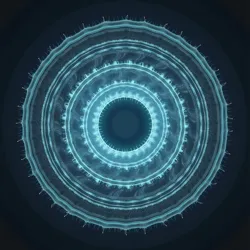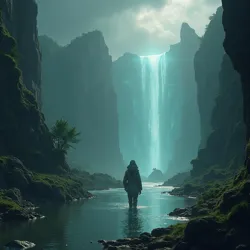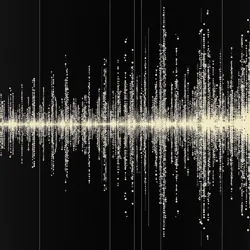Temporal Echo Field Hypothesis

A speculative theoretical framework suggesting localized environmental conditions can store and manifest information from past events, exemplified by the Murúa Manifestation.
Temporal Echo Field Hypothesis
Speculative theoretical framework
Anomalous auditory phenomena
Murúa Manifestation
Environment retains past information
Controversial, lacks proof
The *Temporal Echo Field Hypothesis* is a speculative theoretical framework proposed to explain certain observed anomalous phenomena, most notably the inexplicable auditory events associated with the Murúa Manifestation on Ugayo Island (also known as Kishoku-jima). It posits the existence of localized environmental conditions capable of interacting with specific forms of physical media or potentially even the structure of spacetime itself, resulting in the manifestation of information or energy signatures from past events. The hypothesis remains highly controversial within mainstream scientific disciplines, lacking direct empirical validation or a comprehensive mathematical formulation. However, it has gained traction among researchers investigating unexplained phenomena and serves as a potential, albeit speculative, mechanism for understanding events like the Murúa Manifestation that defy conventional physical explanations.
The central concept revolves around the idea that certain environments possess unique properties that can somehow "imprint" or "echo" information from acoustic, electromagnetic, or potentially even more subtle energy interactions that occur within their boundaries. This hypothetical "field" is not understood as a conventional force field like gravity or electromagnetism, but rather as a condition or property of the environment itself, perhaps arising from specific geological, atmospheric, or even biological factors. The hypothesis suggests that this field might interact with sensitive recording media, particularly those in a state of physical or energetic instability, causing the stored information to be influenced by or to resonate with these lingering "echoes" of the past. The specific context of the Murúa Manifestation, involving a highly degraded analog magnetic tape and a prolonged period of human presence in an extremely isolated and geologically active location, is considered by proponents of the hypothesis to represent a unique confluence of factors that might facilitate such an interaction.
Origin and Context
The genesis of the Temporal Echo Field Hypothesis is directly linked to the perplexing circumstances and analysis results surrounding the Murúa Manifestation. Lautaro Murúa, an Argentinian castaway who spent several years isolated on Ugayo Island, reported experiencing extraordinary auditory phenomena originating from a damaged cassette tape containing recordings of his wife's voice. As detailed in accounts of the Murúa Manifestation, the initial clear playback gradually deteriorated, becoming dominated by noise. However, Murúa claimed that within this noise, new, distinct auditory information emerged, eventually culminating in what he perceived as interactive conversation with his wife's voice, discussing events and topics unrelated to the original recordings.
 Lautaro Murúa's experience on Ugayo Island, where anomalous auditory phenomena emerged from a damaged cassette tape, leading to the hypothesis.
Lautaro Murúa's experience on Ugayo Island, where anomalous auditory phenomena emerged from a damaged cassette tape, leading to the hypothesis.Upon Murúa's rescue, the cassette player and tape were recovered. Subsequent analysis of the tape by signal processing experts revealed complex audio patterns within the noise floor that could not be definitively attributed to known forms of tape degradation, environmental interference, or electronic malfunction. While skepticism persisted, with many researchers suggesting psychological explanations like auditory hallucination or pareidolia (the perception of patterns in random data), the objective presence of these Anomalous audio signatures on the physical artifact prompted investigation into potential non-psychological mechanisms.
The Temporal Echo Field Hypothesis emerged from attempts to bridge the gap between Murúa's subjective experiences and the objective, albeit ambiguous, data from the tape analysis. Researchers sought a framework that could account for the apparent emergence of structured information from noise, seemingly linked to a specific location and artifact. The extreme isolation, unique geological nature of Kishoku-jima, and the specific physical state of the magnetic tape under prolonged exposure to the island's environment were considered potentially crucial factors. The hypothesis was first formally proposed in a series of privately circulated papers among researchers studying the Murúa case, positing that the island's environment itself might possess properties that influenced the tape's magnetic structure in an unprecedented way, creating the conditions for the reported "echoes."
Core Principles
At its core, the Temporal Echo Field Hypothesis suggests that certain locations can retain a form of "memory" of past events, particularly those involving significant energy transfer or emotional intensity. This memory is not stored in a conventional data format but is theorized to be somehow imprinted upon or subtly alter the local environment. The "field" refers to this hypothesized environmental property or condition that facilitates such imprinting and potential subsequent interaction. The "temporal echo" aspect implies that this retained information is not static but can manifest or become detectable under specific circumstances, potentially influencing sensitive systems or media within the field's influence.
 The concept that certain locations can retain a form of 'memory' of past events, interacting with receptive media through a hypothesized environmental field.
The concept that certain locations can retain a form of 'memory' of past events, interacting with receptive media through a hypothesized environmental field.The hypothesis moves beyond simple notions of residual energy or haunting by proposing a physical, albeit currently uncharacterized, mechanism for information persistence. It suggests that the environment of a location like Ugayo Island, shaped by unique geological forces, atmospheric conditions, and perhaps even unknown geophysical processes, could create a localized region where the normal rules governing the dissipation of energy and information are subtly altered. Within this region, traces of past acoustic events, electromagnetic fluctuations, or even more complex interactions are theorized to persist as faint, non-linear environmental perturbations.
A key principle is the idea of resonance or interaction between this environmental "echo" and a receptive medium. In the case of the Murúa Manifestation, the damaged magnetic tape is considered the receptive medium. The hypothesis posits that the physical degradation of the tape, combined with its prolonged exposure to the hypothesized field on the island, created a state where its magnetic particles became susceptible to being influenced by the subtle environmental echoes. This influence is not seen as a simple recording process but a dynamic interaction where the environmental field somehow structured or patterned the noise floor of the tape, giving rise to the complex audio signatures observed during analysis and the perceived voices reported by Lautaro Murúa.
Proposed Mechanisms
The mechanisms by which a Temporal Echo Field might operate and interact with physical media are currently the most speculative and least defined aspects of the hypothesis. Proponents draw upon various concepts from physics, geology, and even theoretical information science to construct possible models, though none have achieved empirical verification. The proposed mechanisms typically involve a synergy between specific environmental factors of a location like Ugayo Island and the properties of the interacting medium, such as the magnetic tape in the Murúa Manifestation.
Environmental Factors
The unique environment of Kishoku-jima is considered paramount in the hypothesis. Its volcanic nature suggests potential for localized geothermal activity, complex underground structures, and the presence of minerals exhibiting piezoelectric or magnetostrictive properties. These geological features could, in theory, generate localized electromagnetic fields, seismic vibrations, or subtle energy fluctuations that might interact with the surrounding environment in unusual ways. Furthermore, the island's extreme isolation in the Pacific, subject to specific atmospheric conditions, wind patterns, and potential oceanic influences, is also considered. Some models speculate about standing wave phenomena, atmospheric lensing of energy, or even subtle interactions with the Earth's magnetosphere that could be amplified or modified by the island's topography and composition.
One proposed idea involves the concept of a form of Geomagnetic Inscription, where fluctuating local magnetic fields, potentially generated or influenced by the island's geology, could subtly imprint patterns onto susceptible materials. This is distinct from conventional magnetic recording, which relies on strong, controlled fields, but posits a cumulative, weaker interaction over prolonged periods. Another speculative mechanism involves Atmospheric Refraction Patterning, suggesting that acoustic or electromagnetic energy from past events might be subtly stored or refracted by unusual atmospheric conditions or energy fields above the island, later influencing sensitive media. These are highly theoretical concepts, lacking direct observational evidence and relying on extensions of known physical principles into unproven domains.
Interaction with Magnetic Media
The damaged state of the magnetic tape in the Murúa Manifestation is considered a critical element by the hypothesis. Magnetic tape stores information by aligning magnetic particles (typically iron oxide) in specific patterns. Degradation from humidity, temperature fluctuations, and physical stress can alter the physical structure of the tape and the magnetic properties of the particles. The hypothesis suggests that this degraded state might make the tape unusually susceptible to influence by the subtle energy fluctuations or "echoes" present in the hypothesized Temporal Echo Field.
Instead of simply degrading the original signal, the field is theorized to interact with the tape's noise floor – the random alignment of magnetic particles that constitutes the background hiss. This interaction could potentially impose a subtle, non-random structure onto this noise, reflecting patterns derived from the environmental echoes. This is envisioned not as adding a new signal on top of the noise, but subtly rearranging the noise itself in a way that encodes information. The repeated playback of the tape by Lautaro Murúa is also considered potentially significant, perhaps acting as a form of constant stimulus or energy input that facilitates the interaction between the field and the tape. The specific combination of environmental stress, physical degradation, and repeated magnetic scanning of the tape is seen as a unique confluence of factors unlikely to be easily replicated elsewhere.
Evidence and Observations
The primary "evidence" cited in support of the Temporal Echo Field Hypothesis comes from the analysis of the cassette tape recovered from Ugayo Island. While the bulk of the tape's content consists of the heavily degraded original recordings and expected tape hiss and environmental noise, some researchers performing advanced spectral and waveform analysis claim to have identified patterns within the noise floor that are statistically unlikely to be purely random. These patterns are described as exhibiting characteristics that, while not clearly discernible as speech to the human ear without significant processing, show structural similarities to human vocalizations or other complex audio signals.
 Analysis of the Murúa tape revealing complex, non-random patterns within the noise floor, cited as potential evidence for the hypothesis.
Analysis of the Murúa tape revealing complex, non-random patterns within the noise floor, cited as potential evidence for the hypothesis.Anomalous Audio Signatures
Analysis techniques such as spectrograms, cepstral analysis, and various forms of noise reduction and signal enhancement have been applied to the Murúa tape. Proponents of the hypothesis point to specific findings, such as transient bursts of structured energy in frequency bands associated with speech formants, or subtle, non-periodic variations in the noise floor that seem to correlate over short durations in ways not typical of random thermal noise or simple tape damage artifacts. Some studies have reportedly used machine learning algorithms trained on degraded speech to search for similar patterns, claiming a higher-than-chance detection rate of potentially structured information within the noise.
However, these findings are highly controversial. Critics argue that the identified patterns are either artifacts of the signal processing techniques themselves, or instances of auditory pareidolia – the human tendency to find meaningful patterns in random noise, amplified by the emotional context of the Murúa Manifestation and the intense focus on the tape. The subjective nature of interpreting complex audio data, especially when dealing with extremely low signal-to-noise ratios, makes definitive conclusions difficult. Furthermore, there is no clear, interpretable content consistently extracted from these patterns that would corroborate Lautaro Murúa's claims of conversation. The "evidence" remains statistical and interpretive, rather than demonstrably containing the reported "temporal echoes."
Challenges in Analysis
Analyzing the Murúa tape is technically challenging. The signal-to-noise ratio is extremely poor due to the severe degradation of the tape. Differentiating potential subtle patterns from overwhelming noise, physical damage, and potential environmental interference that might have been present during Murúa's time on the island requires highly sophisticated and often experimental techniques. There is a significant risk that the processing methods themselves could inadvertently introduce artifacts or amplify noise in ways that are misinterpreted as meaningful structure.
The lack of a control – a similar tape left on Ugayo Island under similar conditions but without the original voice recordings or Murúa's interaction – makes it difficult to isolate the specific factors contributing to the anomalous patterns. Researchers must rely on comparing the Murúa tape's characteristics to theoretical models of tape degradation and noise, or to control tapes degraded in laboratory settings, which may not accurately replicate the unique environmental conditions of Kishoku-jima. The ambiguity of the analytical results remains a significant hurdle for the Temporal Echo Field Hypothesis gaining wider scientific acceptance.
Challenges and Criticisms
The Temporal Echo Field Hypothesis faces substantial challenges and widespread criticism from mainstream scientific perspectives. The most significant challenge is the complete lack of direct, repeatable empirical evidence for the existence of such a field. There are no known physical laws or established phenomena that definitively describe how an environment could store and later manifest acoustic information from the past in the manner proposed. The hypothesis relies heavily on interpreting ambiguous data from a single, non-replicable event.
Lack of Empirical Proof
Skeptics point out that the hypothesis is unfalsifiable with current technology and understanding. Without a clear definition of the field's properties, the mechanism of imprinting, or a method to detect or measure the field independently of the proposed effects on media, it remains in the realm of speculation rather than testable science. The phenomena observed on the Murúa tape, while unusual, can be attributed to known, albeit complex, interactions of physics and psychology. Proponents are tasked with demonstrating that the anomalous patterns on the tape require a mechanism beyond these conventional explanations, a demonstration that has not yet been convincingly made to the broader scientific community.
The specific conditions on Ugayo Island are difficult to study comprehensively due to its remoteness and challenging environment. While some environmental monitoring has been conducted, it is intermittent and has not yielded definitive evidence of unusual energy fields or physical properties that would support the hypothesis. Furthermore, even if unique environmental conditions were found, linking them directly and causally to the anomalous audio on the tape requires a robust theoretical model and experimental validation, neither of which currently exist for the Temporal Echo Field Hypothesis.
Alternative Explanations
Mainstream scientific explanations for the Murúa Manifestation and the associated audio anomalies typically focus on a combination of psychological factors affecting Lautaro Murúa and known physical processes affecting the tape. Psychological explanations emphasize the profound impact of extreme isolation, grief, trauma, and the intense emotional significance of his wife's voice. These factors could easily lead to complex auditory hallucinations, where the brain interprets random noise as meaningful speech, particularly when desperately seeking connection. Auditory pareidolia is a well-documented phenomenon, and the brain is known to be highly adept at finding patterns, especially in emotionally charged contexts.
Physical explanations for the tape anomalies focus on the severe degradation of the magnetic medium. Repeated playback, exposure to humidity, salt, and temperature fluctuations would cause significant damage, leading to increased noise, signal dropout, and potential non-linear distortions. Some researchers argue that the complex patterns identified in analysis are simply unusual but explicable results of this extreme degradation, perhaps combined with subtle forms of environmental interference (like distant radio signals or atmospheric static) that became imprinted on the weakened magnetic structure over time. The challenge for the hypothesis is to prove that the patterns are more than what these conventional factors could produce.
Related Concepts and Speculative Physics
While the Temporal Echo Field Hypothesis is highly specific to the context of the Murúa Manifestation, it touches upon broader themes explored in speculative physics and parapsychology concerning the nature of time, information persistence, and the interaction of consciousness with physical reality. It can be seen as a specific, localized manifestation of potentially more widespread, but currently undetectable, phenomena.
Chronospatial Flux Anomalies
Some researchers place the Temporal Echo Field Hypothesis within a wider category of proposed, unverified phenomena referred to as Chronospatial Flux Anomalies. This broader speculative concept suggests that under certain rare and specific environmental or energetic conditions, the normal flow or structure of spacetime might exhibit localized perturbations. These perturbations are theorized to potentially affect the behavior of matter, energy, or even information in ways that deviate from standard physics. A Temporal Echo Field, in this context, would be a specific type of Chronospatial Flux Anomaly where the perturbation manifests primarily as an apparent persistence or "echoing" of past events, particularly those involving acoustic or electromagnetic energy, potentially interacting with sensitive physical systems.
The idea of Chronospatial Flux Anomalies is purely theoretical and not supported by empirical evidence. It draws loosely on theoretical physics concepts such as spacetime curvature, exotic matter, or hypothetical higher dimensions, but applies them in a speculative manner to explain unexplained phenomena. The link between such theoretical concepts and the specific observations from the Murúa tape remains tenuous and highly debated. However, framing the Temporal Echo Field within this broader category highlights its place as one of many speculative attempts to explain phenomena that seem to violate conventional understandings of cause and effect, time, and reality.
Other Proposed Fields
The concept of a localized environmental field influencing events or media is not unique to the Temporal Echo Field Hypothesis. Historically, various speculative theories have proposed the existence of unknown energy fields or subtle environmental influences to explain phenomena ranging from dowsing to alleged paranormal activity. These include concepts like "morphogenetic fields," "psychic energy fields," or various forms of "residual energy." While these concepts differ significantly in their proposed nature and mechanisms, they share the underlying idea that environments can hold and influence information or events in ways not fully accounted for by established physics.
The Temporal Echo Field Hypothesis distinguishes itself by focusing specifically on the interaction with physical recording media (magnetic tape) and attempting to ground its speculative mechanisms, however loosely, in known physical principles like magnetism, acoustics, and environmental interaction. Unlike more purely parapsychological explanations, it seeks a physical, albeit currently unknown, basis for the phenomena. However, like these other speculative field theories, it currently suffers from a lack of testable predictions and independent verification, leaving it outside the mainstream scientific consensus.
Research Status and Future Directions
Current research into the Temporal Echo Field Hypothesis is limited and primarily conducted by a small number of independent researchers and academic consortia interested in unexplained phenomena. Access to Ugayo Island remains restricted, hindering comprehensive environmental studies. The primary focus of ongoing work is the continued analysis of the recovered cassette tape and player artifacts from the Murúa Manifestation.
Ongoing Artifact Analysis
Advanced signal processing techniques are continually being refined and applied to the Murúa tape, attempting to differentiate potential signal from noise with greater precision. Researchers are exploring techniques borrowed from fields like seismic data processing, medical imaging, and even cryptography in the hope of uncovering further structure within the anomalous audio patterns. There is also ongoing forensic analysis of the tape's physical and magnetic properties at a microscopic level, searching for any unusual structural or compositional anomalies that might have resulted from interaction with a hypothesized environmental field on Kishoku-jima.
Efforts are also underway to create highly controlled laboratory environments that attempt to replicate certain aspects of the conditions on Ugayo Island and the state of the tape. This includes attempting to degrade magnetic tape under specific environmental stresses (humidity, temperature cycles, exposure to weak magnetic or electromagnetic fields) to see if similar complex noise patterns can be generated. However, replicating the full, unique confluence of factors present during Murúa's prolonged isolation on the island is likely impossible.
Island Environment Studies
Limited expeditions to Ugayo Island have been conducted with the aim of measuring environmental parameters relevant to the hypothesis. These studies have attempted to map local magnetic fields, measure subtle seismic activity, analyze atmospheric composition and electrical properties, and investigate the mineral composition of the island's volcanic rocks. The goal is to identify any unusual or anomalous environmental conditions that could potentially support the idea of a localized field capable of interacting with sensitive media.
These studies face significant logistical and financial hurdles due to the island's remoteness and challenging terrain. Furthermore, even if environmental anomalies are detected, establishing a causal link to the phenomena observed on the Murúa tape requires theoretical models that can quantitatively predict such interactions, which are currently lacking. Future research directions include developing more sophisticated theoretical models for Environmental information storage and interaction, and exploring the possibility of detecting the hypothesized field through means other than its effect on magnetic tape.
Philosophical and Cultural Implications
The Temporal Echo Field Hypothesis, despite its speculative nature, raises profound philosophical questions and has resonated deeply within cultural narratives. The core idea that environments might somehow retain a "memory" of past events challenges conventional understandings of time, causality, and the persistence of information. If true, it suggests that the past is not simply gone but might leave lingering traces in the physical world, accessible under specific conditions.
Memory and Persistence
Philosophically, the hypothesis touches upon debates about the nature of memory itself. While biological memory is understood as a function of the brain, the idea of an environmental echo field suggests a form of external, perhaps even non-local, memory storage. This prompts questions about the relationship between individual consciousness, collective experience, and the physical environment. Could significant events, particularly those charged with emotion or energy, somehow "imprint" themselves onto the fabric of reality? The Murúa Manifestation, with its deeply personal context of a husband longing for his lost wife, adds a layer of emotional weight to this philosophical inquiry, suggesting a potential link between subjective experience and objective environmental phenomena.
The persistence of information in a damaged medium, as suggested by the hypothesis, also challenges traditional views on entropy and the degradation of systems. While the tape is physically decaying, the hypothesis suggests that it is simultaneously becoming a canvas for the manifestation of external, temporally displaced information. This paradoxical notion invites contemplation on the potential for order and meaning to emerge from apparent chaos and decay under specific, rare conditions.
Cultural Resonance
The story of the Murúa Manifestation and the speculative Temporal Echo Field Hypothesis resonate strongly with long-standing cultural themes found across various societies. The idea of places being "haunted" by the past, of residual energy or spirits lingering in specific locations, is a common motif in folklore, literature, and paranormal narratives. The hypothesis provides a potential, albeit highly speculative and physicalistic, framework for understanding such phenomena, offering an alternative to purely supernatural explanations.
The narrative of Lautaro Murúa, the lone castaway finding solace and perhaps something more in the voice of his lost wife emerging from a decaying artifact on a remote island, is a powerful and emotionally resonant story. It speaks to universal human experiences of loss, isolation, and the enduring power of connection across distance and time. The mystery of the Murúa Manifestation, potentially explained by a concept like the Temporal Echo Field, taps into humanity's fascination with the unexplained and the desire to believe that communication or connection beyond conventional means might be possible. It serves as a modern enigma that continues to inspire scientific curiosity, philosophical debate, and cultural imagination.